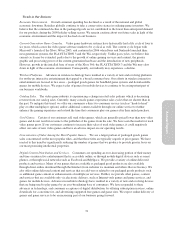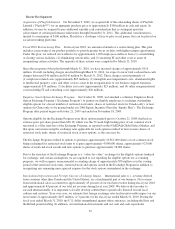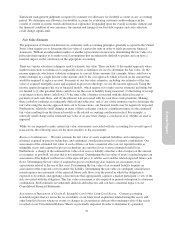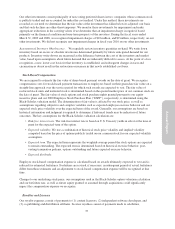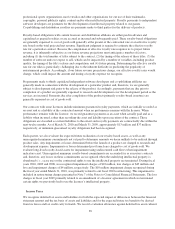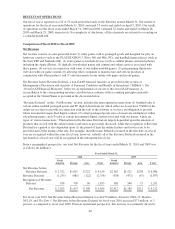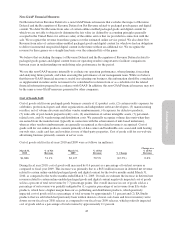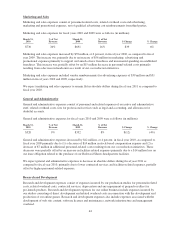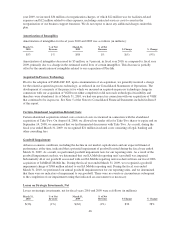Electronic Arts 2010 Annual Report Download - page 116
Download and view the complete annual report
Please find page 116 of the 2010 Electronic Arts annual report below. You can navigate through the pages in the report by either clicking on the pages listed below, or by using the keyword search tool below to find specific information within the annual report.professional sports organizations, movie studios and other organizations for our use of their trademarks,
copyrights, personal publicity rights, content and/or other intellectual property. Royalty payments to independent
software developers are payments for the development of intellectual property related to our games.
Co-publishing and distribution royalties are payments made to third parties for the delivery of products.
Royalty-based obligations with content licensors and distribution affiliates are either paid in advance and
capitalized as prepaid royalties or are accrued as incurred and subsequently paid. These royalty-based obligations
are generally expensed to cost of goods sold generally at the greater of the contractual rate or an effective royalty
rate based on the total projected net revenue. Significant judgment is required to estimate the effective royalty
rate for a particular contract. Because the computation of effective royalty rates requires us to project future
revenue, it is inherently subjective as our future revenue projections must anticipate a number of factors,
including (1) the total number of titles subject to the contract, (2) the timing of the release of these titles, (3) the
number of software units we expect to sell, which can be impacted by a number of variables, including product
quality, the timing of the title’s release and competition, and (4) future pricing. Determining the effective royalty
rate for our titles is particularly challenging due to the inherent difficulty in predicting the popularity of
entertainment products. Accordingly, if our future revenue projections change, our effective royalty rates would
change, which could impact the amount and timing of royalty expense we recognize.
Prepayments made to thinly capitalized independent software developers and co-publishing affiliates are
generally made in connection with the development of a particular product and, therefore, we are generally
subject to development risk prior to the release of the product. Accordingly, payments that are due prior to
completion of a product are generally expensed to research and development over the development period as the
services are incurred. Payments due after completion of the product (primarily royalty-based in nature) are
generally expensed as cost of goods sold.
Our contracts with some licensors include minimum guaranteed royalty payments, which are initially recorded as
an asset and as a liability at the contractual amount when no performance remains with the licensor. When
performance remains with the licensor, we record guarantee payments as an asset when actually paid and as a
liability when incurred, rather than recording the asset and liability upon execution of the contract. These
obligations are classified as current liabilities to the extent such royalty payments are contractually due within the
next twelve months. As of March 31, 2010 and March 31, 2009, approximately $13 million and $37 million,
respectively, of minimum guaranteed royalty obligations had been recognized.
Each quarter, we also evaluate the expected future realization of our royalty-based assets, as well as any
unrecognized minimum commitments not yet paid to determine amounts we deem unlikely to be realized through
product sales. Any impairments or losses determined before the launch of a product are charged to research and
development expense. Impairments or losses determined post-launch are charged to cost of goods sold. We
evaluate long-lived royalty-based assets for impairment using undiscounted cash flows when impairment
indicators exist. Unrecognized minimum royalty-based commitments are accounted for as executory contracts
and, therefore, any losses on these commitments are recognized when the underlying intellectual property is
abandoned (i.e., cease use) or the contractual rights to use the intellectual property are terminated. During fiscal
years 2010, 2009 and 2008, we recognized impairment charges of $10 million, loss charges of $43 million and
loss and impairment charges of $4 million, respectively. The $10 million impairment charge recognized during
the fiscal year ended March 31, 2010, was primarily related to our fiscal 2010 restructuring. This impairment is
included in restructuring charges presented in Note 7 of the Notes to Consolidated Financial Statements. The loss
charges in fiscal year 2009 primarily related to an amendment of a licensor agreement in which we terminated
certain rights we previously had to use the licensor’s intellectual property.
Income Taxes
We recognize deferred tax assets and liabilities for both the expected impact of differences between the financial
statement amount and the tax basis of assets and liabilities and for the expected future tax benefit to be derived
from tax losses and tax credit carry forwards. We record a valuation allowance against deferred tax assets when it
38





